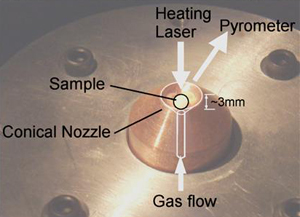
Aerodynamic levitation
Encyclopedia

Aerodynamic levitation
Levitation
Levitation is the process by which an object is suspended by a physical force against gravity, in a stable position without solid physical contact...
is the use of gas pressure to levitate materials so that they are no longer in physical contact with any container. In scientific experiments this removes contamination and nucleation issues associated with physical contact with a container.
Overview
The term aerodynamic levitation could be applied to many objects that use gas pressure to counter the force of gravity, and allow stable levitationLevitation
Levitation is the process by which an object is suspended by a physical force against gravity, in a stable position without solid physical contact...
. Helicopters and air hockey pucks are two good examples of objects that are aerodynamically levitated. However, more recently this term has also been associated with a scientific technique which uses a cone-shaped nozzle allowing stable levitation of 1-3mm diameter spherical samples without the need for active control mechanisms .
Aerodynamic levitation as a scientific tool
These systems allow spherical samples to be levitated by passing gas up through a diverging conical nozzle. Combining this with >200W continuous CO2 laserCarbon dioxide laser
The carbon dioxide laser was one of the earliest gas lasers to be developed , and is still one of the most useful. Carbon dioxide lasers are the highest-power continuous wave lasers that are currently available...
heating allows sample temperatures in excess of 3000 degrees Celsius to be achieved.
When heating materials to these extremely high temperatures levitation in general provides two key advantages over traditional furnaces. First, contamination that would otherwise occur from a solid container is eliminated. Second, the sample can be undercooled, i.e. cooled below it’s normal freezing temperature, without actually freezing.
Undercooling of liquid samples
Undercooling, or supercoolingSupercooling
Supercooling, also known as undercooling, is the process of lowering the temperature of a liquid or a gas below its freezing point without it becoming a solid....
, is the cooling of a liquid below its equilibrium freezing temperature while it remains a liquid. This can occur wherever crystal nucleation
Nucleation
Nucleation is the extremely localized budding of a distinct thermodynamic phase. Some examples of phases that may form by way of nucleation in liquids are gaseous bubbles, crystals or glassy regions. Creation of liquid droplets in saturated vapor is also characterized by nucleation...
is suppressed. In levitated samples, heterogeneous nucleation is suppressed due to lack of contact with a solid surface. Levitation techniques typically allow samples to be cooled several hundred degrees Celsius below their equilibrium freezing temperatures.
Glass produced by Aerodynamic Levitation
Since crystal nucleation is suppressed by levitation, and since it is not limited by sample conductivity (unlike electromagnetic levitation), aerodynamic levitation can be used to make glassy materials that cannot be made by any other method. Several silica-free, aluminium oxide based glasses have been made.Physical Property Measurements
In the last few years a range of in situIn situ
In situ is a Latin phrase which translated literally as 'In position'. It is used in many different contexts.-Aerospace:In the aerospace industry, equipment on board aircraft must be tested in situ, or in place, to confirm everything functions properly as a system. Individually, each piece may...
measurement techniques have also been developed. The following measurements can be made with varying precision:
electrical conductivity,
viscosity
Viscosity
Viscosity is a measure of the resistance of a fluid which is being deformed by either shear or tensile stress. In everyday terms , viscosity is "thickness" or "internal friction". Thus, water is "thin", having a lower viscosity, while honey is "thick", having a higher viscosity...
,
density
Density
The mass density or density of a material is defined as its mass per unit volume. The symbol most often used for density is ρ . In some cases , density is also defined as its weight per unit volume; although, this quantity is more properly called specific weight...
,
surface tension
Surface tension
Surface tension is a property of the surface of a liquid that allows it to resist an external force. It is revealed, for example, in floating of some objects on the surface of water, even though they are denser than water, and in the ability of some insects to run on the water surface...
,
specific heat capacity,
In situ aerodynamic levitation has also been combined with:
X-ray synchrotron radiation
Synchrotron radiation
The electromagnetic radiation emitted when charged particles are accelerated radially is called synchrotron radiation. It is produced in synchrotrons using bending magnets, undulators and/or wigglers...
,
neutron scattering
Neutron scattering
Neutron scattering,the scattering of free neutrons by matter,is a physical processand an experimental technique using this processfor the investigation of materials.Neutron scattering as a physical process is of primordial importance...
,
NMR spectroscopy
NMR spectroscopy
Nuclear magnetic resonance spectroscopy, most commonly known as NMR spectroscopy, is a research technique that exploits the magnetic properties of certain atomic nuclei to determine physical and chemical properties of atoms or the molecules in which they are contained...
See also
- Magnetic levitationMagnetic levitationMagnetic levitation, maglev, or magnetic suspension is a method by which an object is suspended with no support other than magnetic fields...
- Electrostatic levitationElectrostatic levitationElectrostatic levitation is the process of using an electric field to levitate a charged object and counteract the effects of gravity. It was used, for instance, in Robert Millikan's oil drop experiment and is used to suspend the gyroscopes in Gravity Probe B during launch.Due to Earnshaw's...
- Optical levitationOptical levitationOptical levitation is a method developed by Arthur Ashkin whereby a material is levitated against the downward force of gravity by an upward force stemming from photon momentum transfer...
- Acoustic levitationAcoustic levitationAcoustic levitation is a method for suspending matter in a medium by using acoustic radiation pressure from intense sound waves in the medium. Acoustic levitation is possible because of the non-linear effects of intense sound waves....

